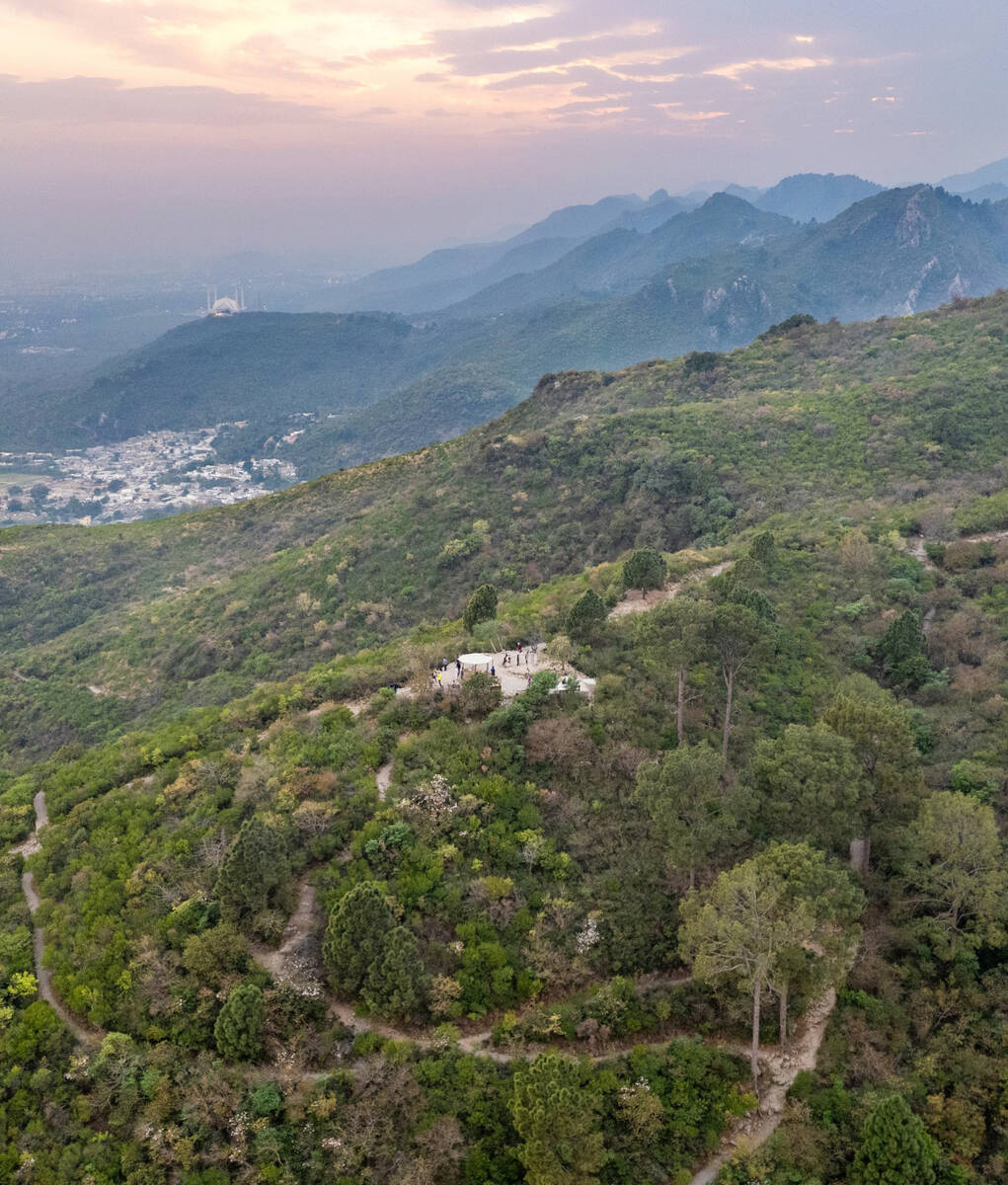HELSINKI: Finland has topped an index of the happiest nations for the second consecutive year, with researchers saying the small Nordic country has succeeded in generating a happiness recipe not simply dependent on economic wealth.
The World Happiness Report, produced by the UN Sustainable Development Solutions Network, ranks 156 countries by how happy their citizens see themselves to be. It’s based on factors including economic wealth, life expectancy, social support and freedom to make life choices.
The index, published Wednesday, showed the other Nordic countries did well, with Denmark, Norway and Iceland taking the next spots.
The United States dropped from the 18th to 19th place.
Happiness has declined the most drastically in the past ten years in the 108th placed Venezuela, currently in political crisis.
Finland tops global happiness index for second consecutive year
Finland tops global happiness index for second consecutive year

- The World Happiness Report ranks 156 countries by how happy their citizens see themselves to be
- Happiness has declined the most drastically in the past ten years in the 108th placed Venezuela
A Venus flytrap wasp? Scientists uncover an ancient insect preserved in amber that snatched its prey
A Venus flytrap wasp? Scientists uncover an ancient insect preserved in amber that snatched its prey

- Scientists uncovered over a dozen female wasps preserved in 99-million-year-old amber from the Kachin region in northern Myanmar
- It’s a playbook adapted by many parasitic wasps, including modern-day cuckoo and bethylid wasps, to exploit insects
NEW YORK: An ancient wasp may have zipped among the dinosaurs, with a body like a Venus flytrap to seize and snatch its prey, a new study says.
The parasitic wasp’s abdomen boasts a set of flappy paddles lined with thin bristles, resembling “a small bear trap attached to the end of it,” said study co-author Lars Vilhelmsen from the Natural History Museum of Denmark.
Scientists uncovered over a dozen female wasps preserved in 99-million-year-old amber from the Kachin region in northern Myanmar. The wasp’s flaps and teeth-like hairs resemble the structure of the carnivorous Venus flytrap plant, which snaps shut to digest unsuspecting insects. But the design of the wasp’s getup made scientists think its trap was designed to cushion, not crush.
Instead, researchers suggested the flytrap-like structure was used to hold a wriggly insect still while the wasp laid an egg, depositing a baby wasp to feed on and drain its new host.
It’s a playbook adapted by many parasitic wasps, including modern-day cuckoo and bethylid wasps, to exploit insects. But no known wasp or any other insect does so with bizarre flaps quite like this one.
“I’ve seen a lot of strange insects, but this has to be one of the most peculiar-looking ones I’ve seen in a while,” said entomologist Lynn Kimsey from the University of California, Davis, who was not involved with the research.
Scientists named the new wasp Sirenobethylus charybdis, partly for the sea monster from Greek mythology that stirred up wild whirlpools by swallowing and expelling water.
The new study was published in the journal BMC Biology and included researchers from Capital Normal University and the Beijing Xiachong Amber Museum in China.
It’s unclear when the wasp went extinct. Studying unusual insects like this one can help scientists understand what insects are capable of and how different they can be.
“We tend to think that the cool things are only found today,” said Gabriel Melo, a wasp expert at the Federal University of Paraná in Brazil, who had no role in the study. “But when we have this opportunity, we see that many really exceptional, odd things already happened.”
Fitness enthusiasts challenge themselves with pre-iftar hikes in Pakistani capital

- Hikers set out hour before sunset, break fast on trails on Margalla Hills National Park
- Participants say pre-iftar hikes help boost fat burning, maintain weight in Ramadan
ISLAMABAD: Zarnab Tahir struggled to catch her breath as the steep incline of the hiking trail at Islamabad’s picturesque Margalla Hills tested her endurance. Hiking can put people through physical exertion, especially when they do it on an empty stomach.
An hour before the sun sets and the call to prayer blares out from various mosques located in Pakistan’s capital city, a group of fitness enthusiasts take to the hiking trails in Margalla Hills National Park.

Islamabad Run With Us — IRU — which describes itself as Pakistan’s “pioneering running community,” is behind the pre-iftar hiking initiative.
“When you engage in pre-iftar (physical) activities during Ramadan, it gives you extra energy, an extra boost,” Qasim Naz, who founded IRU in 2016, told Arab News on hiking trail number three.

“And when someone joins in on an activity once or twice, they figure out it’s not that hard and they can sustain it comfortably.”
Naz stresses that staying active during the holy month is essential. The IRU organizes five activities a week, which include two runs and three hikes.

“Either we can maintain our weight, or if our goal is weight loss, we can achieve it by being in a calorie deficit while eating a healthy diet and exercising,” Naz explained.
Tahir, 22, meanwhile, said that she was committed to reaching the top of hiking trail before sunset. This was the second time she was hiking with IRU.

She agreed with Naz that group activities are “much easier” to sustain.
“I think it is important to go at your own pace and it’s so much easier with the group,” Tahir, a content creator, told Arab News.

“If you go alone, it’s kind of more difficult and you are, like, really slow but if you go with the group you can maintain that pace and I think it’s much easier that way.”
Mahwish Ashraf, a journalist associated with a foreign diplomatic mission in Islamabad, shared how she struggled the first time that she went on a pre-iftar hike with IRU.
“The first time I was hiking, I returned from in between, I couldn’t complete it,” she admitted. “So, this is my second time hiking with the IRU, and gladly, I’m at the main point, the meeting point.”
Eraj Khan, a commercial specialist visiting from Australia to spend Ramadan with his family, said pre-iftar hikes give one “lots of energy.”
“For fat burning, it’s a great activity,” Khan said. “Especially because the last two hours of fasting are the hardest, most people feel really hungry. But so far, I’m loving it.”
As the clock continued to tick and evening settled in, the hikers began to pick up their pace. For Tahir, reaching the top of the trail before sunset was a victory in itself.
She had pushed past exhaustion, embraced the challenge and proved to herself that she was capable of more than she thought she could achieve.
And according to her, hiking with the group made all the difference.
“The energy of the group keeps you going,” she said. “Even when you feel like stopping, you see everyone else moving forward, and you push through.”
Arctic sea ice hits lowest peak in satellite record, says US agency

- Arctic sea ice forms and expands during the dark, frigid northern winter, reaching its seasonal high point in March
- In recent years, less new ice has formed, and the accumulation of multi-year ice has steadily declined
WASHINGTON: This year’s Arctic Sea ice peak is the lowest in the 47-year satellite record, according to data released by the US National Snow and Ice Data Center (NSIDC) on Thursday, as the planet continues to swelter under the mounting effects of human-driven climate change.
Arctic sea ice forms and expands during the dark, frigid northern winter, reaching its seasonal high point in March. But in recent years, less new ice has formed, and the accumulation of multi-year ice has steadily declined.
The maximum sea ice level for 2025 was likely reached on March 22, measuring 14.33 million square kilometers (5.53 million square miles) — below the previous low of 14.41 million square kilometers set in 2017.
“This new record low is yet another indicator of how Arctic sea ice has fundamentally changed from earlier decades,” said NSIDC senior research scientist Walt Meier in a statement.
“But even more importantly than the record low is that this year adds yet another data point to the continuing long-term loss of Arctic sea ice in all seasons.”
The Arctic record follows a near-record-low summer minimum in the Antarctic, where seasons are reversed.
The 2025 Antarctic sea ice minimum, reached on March 1, was just 1.98 million square kilometers, tying for the second-lowest annual minimum in the satellite record, alongside 2022 and 2024.
Combined Arctic and Antarctic sea ice cover — frozen ocean water that floats on the surface — plunged to a record low in mid-February, more than a million square miles below the pre-2010 average. That is an area larger than the entire country of Algeria.
“We’re going to come into this next summer season with less ice to begin with,” said Linette Boisvert, an ice scientist at NASA’s Goddard Space Flight Center in Greenbelt, Maryland. “It doesn’t bode well for the future.”
US scientists primarily monitor sea ice using satellites from the Defense Meteorological Satellite Program (DMSP), which detect Earth’s microwave radiation.
Because open water and sea ice emit microwave energy differently, the contrast allows sea ice to stand out clearly in satellite imagery — even through cloud cover, which obscures traditional optical sensors.
DMSP data is supplemented with historical records, including early observations from the Nimbus-7 satellite, which operated from 1978 to 1985.
While floating sea ice does not directly raise sea levels, its disappearance sets off a cascade of climate consequences, altering weather patterns, disrupting ocean currents, and threatening ecosystems and human communities.
As reflective ice gives way to the darker ocean, more solar energy is absorbed rather than reflected back into space, accelerating both ice melt and global warming.
Shrinking Arctic ice is also reshaping geopolitics, opening new shipping lanes and drawing geopolitical interest. Since taking office this year, US President Donald Trump has said his country must control Greenland, a Danish autonomous territory rich in mineral resources.
The loss of polar ice spells disaster for numerous species, robbing polar bears, seals, and penguins of crucial habitat used for shelter, hunting, and breeding.
Last year was the hottest on record, and the trend continues: 2025 began with the warmest January ever recorded, followed by the third-warmest February.
NOAA predicts that La Nina weather conditions, which tend to cool global temperatures, are likely to give way to neutral conditions that would persist over the Northern Hemisphere summer.
Polar regions are especially vulnerable to global warming, heating several times faster than the global average.
Since mid-2023, only July 2024 fell below 1.5 degrees Celsius of warming, raising concerns that the Paris Agreement’s goal of limiting long-term warming to 1.5C may be slipping out of reach.
Satanist leader’s attempt to hold ‘Black Mass’ inside US statehouse sparks chaos and arrests

- Kansas City-area Satanic Grotto rallied to protested what members called the state’s favoritism toward Christians in allowing events inside the statehouse
- Members of the satanic cult said their rally was in support free speech rights and religious freedoms guaranteed by the US Constitution’s First Amendment
TOPEKA, Kansas: The leader of a small group of self-described satanists and at least one other person were arrested Friday following a scuffle inside the Kansas Statehouse arising from an effort by the group’s leader to start a “Black Mass” in the rotunda.
About 30 members of the Kansas City-area Satanic Grotto, led by its president, Michael Stewart, rallied outside the Statehouse for the separation of church and state. The group also protested what members called the state’s favoritism toward Christians in allowing events inside. Gov. Laura Kelly temporarily banned protests inside, just for Friday, weeks after Stewart’s group scheduled its indoor ceremony.
The Satanic Grotto’s rally outside drew hundreds of Christian counterprotesters because of the Grotto’s satanic imagery, and its indoor ceremony included denouncing Jesus Christ, who Christians believe is the Son of God. About 100 Christians stood against yellow police tape marking the Satanic Grotto’s area. The two groups yelled at each other while the Christians also sang and called on Grotto members to accept Jesus. Several hundred more Christians rallied on the other side of the Grotto’s area, but further away.
Kelly issued her order earlier this month after Roman Catholic groups pushed her to ban any Satanic Grotto event. The state’s Catholic Bishops called what the group planned “a despicable act of anti-Catholic bigotry” mocking the Catholic Mass. Both chambers of the Legislature also approved resolutions condemning it.

“The Bible says Satan comes to steal, kill and destroy, so when we dedicate a state to Satan, we’re dedicating it to death,” said Jeremiah Hicks, a pastor at the Cure Church in Kansas City, Kansas.
Satanic Grotto members, who number several dozen, said they hold a variety of beliefs. Some are atheists, some use the group to protest harm they suffered as church members, and others see Satan as a symbol of independence.
Amy Dorsey, a friend of Stewart’s, said she rallied with the Satanic Grotto to support free speech rights and religious freedoms guaranteed by the US Constitution’s First Amendment, in part because Christian groups are allowed to meet regularly inside the Statehouse for prayer or worship meetings.
Before his arrest, Stewart said his group scheduled its Black Mass for Friday because it thought the Kansas Legislature would be in session, though lawmakers adjourned late Thursday night for their annual spring break. Stewart said the group might come back next year.
“Maybe un-baptisms, right here in the Capitol,” he said.
Video shot by KSNT-TV showed that when Stewart tried to conduct his group’s ceremony in the first-floor rotunda, a young man tried to snatch Stewart’s script from his hands, and Stewart punched him. Several Kansas Highway Patrol troopers wrestled Stewart to the ground and handcuffed him. They led him through hallways on the ground floor below and into a room as he yelled, “Hail, Satan!”
Stewart’s wife, Maenad Bee, told reporters, “He’s only exercising his First Amendment rights.”

Online records showed that Stewart was jailed briefly Friday afternoon on suspicion of disorderly conduct and having an unlawful assembly, then released on $1,000 bond.
Witnesses and friends identified the young man trying to snatch away the script as Marcus Schroeder, who came to counterprotest with fellow members of a Kansas City-area church. Online records show Schroeder was arrested on suspicion of disorderly conduct, with his bond also set at $1,000.
Dorsey said two other Satanic Grotto members also were detained, but didn’t have details. The Highway Patrol did not immediately confirm any arrests or detentions.
A friend of Schroeder’s, Jonathan Storms, said he was trying to help a woman who also sought to snatch away Stewart’s script and “didn’t throw any punches.”
The woman, Karla Delgado, said she came to the Statehouse with her three youngest children to deliver a petition protesting the Black Mass to Kelly’s office. Delgado said she approached Stewart because he was violating the governor’s order and Highway Patrol troopers weren’t immediately arresting him. She said in the ensuing confusion, her 4-year-old daughter was knocked to the ground.
“When we saw that nobody was doing anything — I guess just in the moment of it — it was like, ‘He’s not supposed to be allowed to do this,’ so we tried to stop him,” she said.
Child slips through fencing at White House and is intercepted by Secret Service

- Similar intrusions have happened at th White House before, including in April 2023 when a toddler squeezed through the metal fencing
WASHINGTON: A child slipped through fencing outside the White House on Wednesday and was intercepted by Secret Service officers.
Secret Service spokesperson Anthony Guglielmi said the young trespasser squeezed through the fence on the North Lawn around 6:30 p.m., about an hour after President Donald Trump announced planned auto tariffs from the Oval Office.
“Officers quickly reunited the child with their parents without incident,” Guglielmi said in a social media post.

Video posted on social media shows an armed officer carrying a young child wearing a blue hooded sweatshirt across the lawn before handing off the child to another officer.
Such intrusions have happened before. In April 2023, a toddler squeezed through the metal fencing, also on the North Lawn, and was later reunited with his parents, who were briefly questioned.






















